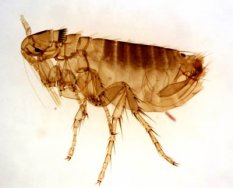Fleas
 Fleas attack pets, man, and warm blooded animals (hosts) to feed. Fleas are small, wingless insects, which are dark in color and have strong legs that enable them to swiftly jump long distances. People often first become aware of flea infestations due to itching and annoying flea bites rather then usually spotting the pest. Bites most commonly occur in the ankles and may consist of 2 - 3 bites in a row. Dogs that are being attacked by fleas may suddenly stop and scratch excessively or bite affected areas. In severe cases, the dog may experience hair loss or skin infections. Fleas transmit disease and also tapeworms. Fleas also transmit Typhoid fever and bubonic plaque. A flea can jump 7 to 8 inches vertically and 14 - 16 inches horizontally. Fleas can live without a host for weeks. The most common fleas are the cat fleas. Fleas are attracted to body heat, movement, and carbon dioxide exhaled.
Fleas attack pets, man, and warm blooded animals (hosts) to feed. Fleas are small, wingless insects, which are dark in color and have strong legs that enable them to swiftly jump long distances. People often first become aware of flea infestations due to itching and annoying flea bites rather then usually spotting the pest. Bites most commonly occur in the ankles and may consist of 2 - 3 bites in a row. Dogs that are being attacked by fleas may suddenly stop and scratch excessively or bite affected areas. In severe cases, the dog may experience hair loss or skin infections. Fleas transmit disease and also tapeworms. Fleas also transmit Typhoid fever and bubonic plaque. A flea can jump 7 to 8 inches vertically and 14 - 16 inches horizontally. Fleas can live without a host for weeks. The most common fleas are the cat fleas. Fleas are attracted to body heat, movement, and carbon dioxide exhaled.
Fleas go through three stages before they become adults (egg, larva, and pupa). It can take from 30 days to one year to complete this cycle. The immature stages are most commonly found in areas where the host animal rests and visits frequently. Eggs are laid on the animal and generally fall off and land on surfaces like carpet and other surfaces. Larvae emerge from the eggs and feed on organic debris and adult flea feces in the carpet areas and other surfaces. The adult flea is the only stage mainly found on the animal. Adult fleas will live for 7 to 10 days on average and the females will lay around 150 eggs during that time span.
There are many important factors to consider when trying to control and eliminate flea infestations. Contact your area pest control company for details on control measures and also check with your vet for treatment options and methods available for your pets.
